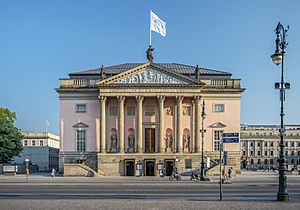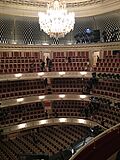Berlin State Opera facts for kids
|
Staatsoper Unter den Linden
|
|
 |
|
| Named after | Unter den Linden boulevard |
|---|---|
| Formation | 1743 |
| Location |
|
| Elisabeth Sobotka | |
|
General Music Director
|
Christian Thielemann |
| Website | staatsoper-berlin.de |
The Staatsoper Unter den Linden (which means 'State Opera under the Lime Trees') is also known as the Berlin State Opera. It is a famous building located on the Unter den Linden boulevard in the historic center of Berlin, Germany. This amazing opera house was built a long time ago, between 1741 and 1743. It was ordered by the Prussian king Frederick the Great and designed by Georg Wenzeslaus von Knobelsdorff in a style called Palladian.
During World War II, the opera house was damaged by bombs. It used to be called the Royal Prussian Opera House. After the war, it was rebuilt from 1951 to 1955. It is part of the Forum Fridericianum square in what was then East Berlin. People sometimes call it Lindenoper. It is known as "the world's oldest state opera" and was the first theater to be a large, stand-alone building in a city.
Contents
History of the Opera House
Different Names Over Time
When it first opened, the opera company was called the Königliche Oper, which means 'Royal Opera'. In 1919, after a big change in Germany, it was renamed the Preußische Staatsoper, or 'Prussian State Opera'. After World War II, it became the national opera company for Communist East Germany. In 1955, it changed its name again to Deutsche Staatsoper, meaning 'German State Opera'.
However, many people, especially in West Germany, often called it the Staatsoper Unter den Linden. This name came from the famous street it sits on. After Germany became one country again in 1990, this name became even more popular. It was officially adopted in 1995.
The Early Years of the Opera
King Frederick II of Prussia ordered the building to be constructed soon after he became king. The building was important because it was one of the first examples of the Palladian style in Germany. Construction started in July 1741. It was designed by Georg Wenzeslaus von Knobelsdorff as the first part of a larger plan called "Forum Fredericianum." Even though it wasn't fully finished, the Court Opera (Hofoper) opened on December 7, 1742. The first show was an opera called Cesare e Cleopatra by Carl Heinrich Graun. This event started a long and successful partnership between the Staatsoper and the Staatskapelle Berlin. This state orchestra has been around since the 1500s.
In 1821, the Berlin Opera, which was performing at the Schauspielhaus Berlin at the time, showed the very first performance of Weber's Der Freischütz. Later, in 1842, Wilhelm Taubert started the tradition of regular symphony concerts. In the same year, Giacomo Meyerbeer became the General Music Director. Felix Mendelssohn also conducted symphony concerts there for a year.
Sadly, on August 18, 1843, the Linden Opera was destroyed by a fire. The building was rebuilt quickly by architect Carl Ferdinand Langhans. The Royal Opera House (Königliches Opernhaus) reopened the next autumn. The first performance was Meyerbeer's Ein Feldlager in Schlesien. In 1849, Otto Nicolai's Die lustigen Weiber von Windsor had its first performance at the Royal Opera House, conducted by the composer himself.
The 20th Century at the Opera
At the end of the 1800s and beginning of the 1900s, many famous conductors worked at the Royal Court Opera in Berlin. These included Felix von Weingartner, Karl Muck, Richard Strauss, Leo Blech, and George Szell. After the German Empire ended in 1918, the Opera was renamed Staatsoper Unter den Linden. The Royal Orchestra became the Kapelle der Staatsoper.
In the 1920s, conductors like Kurt Adler, Wilhelm Furtwängler, Erich Kleiber, Otto Klemperer, Alexander von Zemlinsky, and Bruno Walter worked there. In 1925, Alban Berg's opera Wozzeck had its first performance. It was conducted by Erich Kleiber, and the composer was there to see it.
After a big renovation, the Linden Opera reopened on April 28, 1928. The first show was a new production of Mozart's Die Zauberflöte. Famous singers like Delia Reinhardt and Richard Tauber performed. The famous Russian singer Feodor Chaliapin and Serge Diaghilev's Ballets Russes also performed as guests. In 1930, Erich Kleiber conducted the first performance of Darius Milhaud's Christophe Colomb. However, in 1934, after Erich Kleiber performed music from Alban Berg's Lulu, the government at the time caused problems, and Kleiber had to leave the country.
During the time of the Nazis, many musicians of Jewish background were removed from the opera company. Many German musicians also left the country, including conductors Kurt Adler, Otto Klemperer, and Fritz Busch. Clemens Krauss became a conductor at the Berlin State Opera in 1933 and then its director in 1935. This happened after Fritz Busch and Erich Kleiber resigned because they disagreed with the Nazi government. During this time, Herbert von Karajan (1939–1945) was one of the main conductors.
The opera house was destroyed again by an air raid on April 9, 1941. Even though it was wartime and supplies were short, the leader ordered it to be rebuilt right away to boost morale. It reopened on December 12, 1942, with a performance of Die Meistersinger von Nürnberg, conducted by Wilhelm Furtwängler. This celebrated the building's 200th anniversary.
However, the opera house was ruined once more in another air raid on February 3, 1945. Three bombs hit it, destroying most of the building, except for the main front on Unter den Linden street.
After the Wars
The second rebuilding took a long time. From 1945, the opera company performed at the Admiralspalast. From 1949, the company served as the state opera for East Germany. It finally moved back to its original home in 1955 after the rebuilding was finished. The newly rebuilt opera house opened again with Wagner's Die Meistersinger von Nürnberg. After the Berlin Wall was built in 1961, the Opera was somewhat cut off. However, it still performed many classic and romantic operas, along with modern ballets and operas.
After Germany became one country again, the Linden Opera rejoined the international opera world. Important works that had been performed in the past were brought back and discussed. Baroque Opera, a style from a long time ago, became very important. Operas like Graun's Cleopatra e Cesare and Scarlatti's Griselda were performed. These shows were led by Belgian conductor René Jacobs with orchestras that used old instruments. In the 1990s, the opera was officially renamed Staatsoper Unter den Linden.
In 1992, the conductor Daniel Barenboim became the General Music Director (GMD). In 2000, the orchestra chose Barenboim to be their "conductor for life." In 2009, the Berlin State Opera closed for more renovation work. This work was led by German architect HG Merz. The roof of the building was raised, and the stage area was made longer to make the sound better. Now, 1,350 people can watch a show there. Other parts of the building were also renovated and expanded. The opera house reopened in 2017 with new performances of Humperdinck's Hänsel und Gretel and Monteverdi's L'incoronazione di Poppea. The opera house is also home to the Staatskapelle Berlin orchestra.
On January 6, 2023, the company announced that Daniel Barenboim was stepping down as GMD due to health reasons. In January 2023, Christian Thielemann stepped in as a substitute conductor for a new production of Richard Wagner's Der Ring des Nibelungen. In September 2023, the company announced that Thielemann would be the next GMD, starting on September 1, 2024.
Opera Leaders and Conductors
- Carl Heinrich Graun (1742–1759)
- Johann Friedrich Agricola (1759–1775)
- Johann Friedrich Reichardt (1775–1794)
- Gaspare Spontini (1820–1841)
- Giacomo Meyerbeer (1842–1846)
- Otto Nicolai (1848–1849)
- Richard Strauss (1899–1913)
- Erich Kleiber (1923–1934, 1954–1955)
- Clemens Krauss (1935–1936)
- Herbert von Karajan (1941–1945)
- Joseph Keilberth (1948–1951)
- Franz Konwitschny (1955–1962)
- Otmar Suitner (1964–1990)
- Daniel Barenboim (1992–2023)
- Christian Thielemann (2024–present)
See also
 In Spanish: Staatsoper Unter den Linden para niños
In Spanish: Staatsoper Unter den Linden para niños









